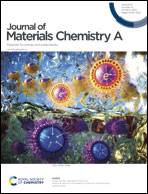A spatially efficient “tube-in-tube” hybrid for durable sulfur electrochemistry†
Abstract
The structural modification of sulfur hosts, which involves tailorable structural designability, superior porous architecture, and administrable catalytic modifiability, is essential to overcome the current obstacles (insufficient utilization rate and precarious cell cycling) facing lithium sulfur batteries (LSBs). Hence, a spatially efficient “tube-in-tube” carbonaceous host decorated with defective metallic nitride nanoparticles (Fe2N1−x-NCT25) is constructed and validated to alleviate the abovementioned problems via constructing a highly utilized/volumetric-stabilized sulfur host with multiple electrical/ionic conductive channels. Owing to the presence of spatial confinement and durable catalyzed capability afforded by the as-fabricated hierarchical host, the sulfur cathode delivers a high reversible discharge capacity of 808 mA h g−1 under the conditions of 1C rate with 90 wt% sulfur content. In addition, a high areal capacity of 5.26 mA h cm−2, a superb cyclability of 100 cycles and an ultra-low capacity fading rate of 0.013% per cycle are observed at 1C. The reliable LiPS adsorption and administrable LiPS shuttling effect are attributed to the well-developed interactions/conversion between the LiPSs and defective metallic nitride particles, which was further confirmed by theoretical calculations. This work affords the synergistic construction of a structural carbonaceous host for sulfur utilization and an anchored defective catalyst towards rapid and reliable sulfur electrochemistry, leading to enormous prospects in developing applicable LSBs.



 Please wait while we load your content...
Please wait while we load your content...